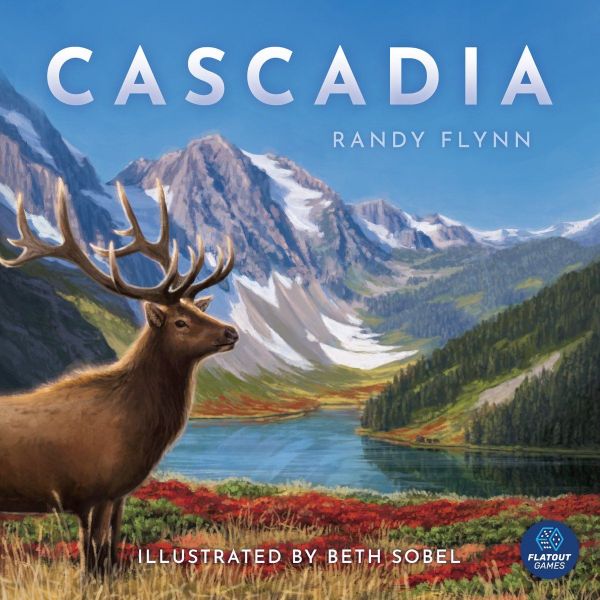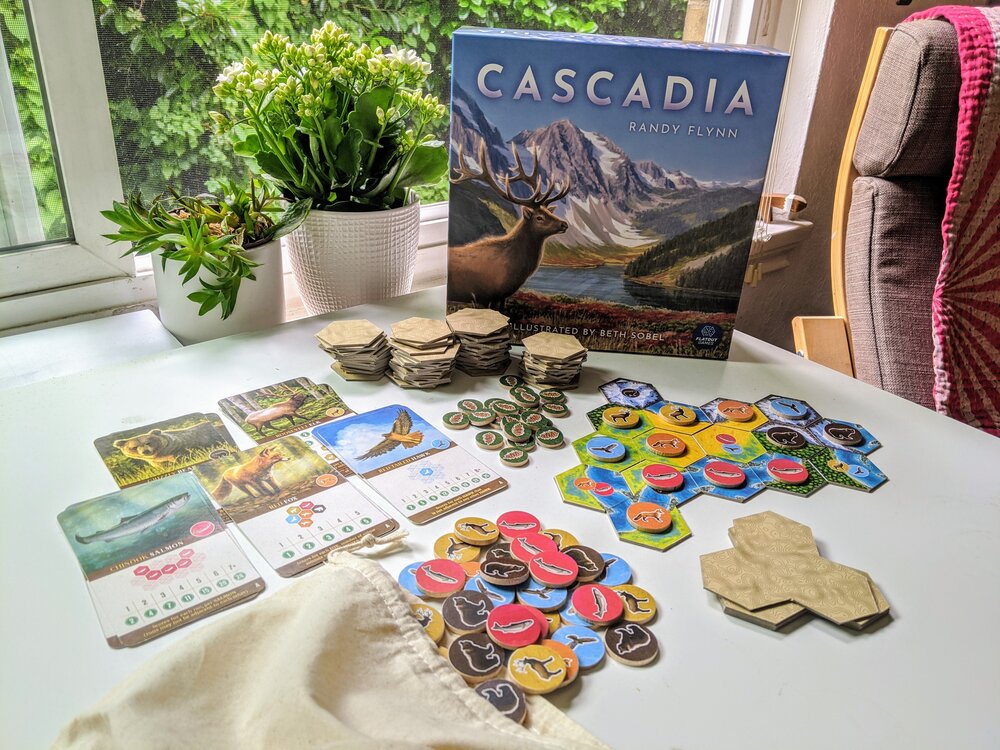Explore the Pacific Northwest Ecosystem in Cascadia

Randy Flynn’s tile-laying phenomenon is the latest puzzler in Flatout Games’s growing oeuvre.
Gameplay
Cascadia is a 1-4 player game in which players will be trying to create a robust and harmonic ecosystem by aligning hexagon tiles of terrain while making patterns with a host of native animals within their tableaus.
Play begins with each player drawing one of the Starter Habitat tiles. Shuffle the Habitat tiles (totals are dependent on the player count) face-down in a stack and draw 4 Habitat tiles along with 4 corresponding Wildlife tokens from the bag to create a central market. Players will take turns drafting a tile and a token from the same column and placing them in their habitats.
Tiles have various terrain types and, though players are not required to match terrain types when placing into their habitat tableau, more points will be scored at game’s end for larger areas of connected terrains. The only rule of placing a Habitat tile into one’s tableau is that at least one side must be flush against another side of the player’s habitat. Likewise, players then place the Wildlife token into their habitat, obeying the rules of what animals are allowed on those tiles.
The purpose of Wildlife token placement is dictated by Wildlife scoring cards. These cards present how animals should be grouped and/or placed to earn points. Sometimes the scoring will be set (any three bears in a group being worth a set number of points) while others may be dependent on the types of animals around them, including creating runs of the same type. The more a player has, the more points that may be scored at game’s end. If a player cannot place a Wildlife token they have chosen into their habitat, they are returned to the bag.
Habitat tiles also include Keystone tiles, which are denoted with a white Nature Token symbol. If the corresponding Wildlife token is placed on these, players will earn a Nature Token. Nature Tokens are worth points at the end of the game, but they are also useful in manipulating the market by allowing players to spend one Nature Token to take any tile and any token or to wipe all the Wildlife tokens from the market and drawing four new ones.
Once a player has taken their tile and token, it is replaced by a tile from the stack and a token from the bag. Play continues until there are no more face-down tiles, which will mean 20 turns for each player. Totals are tallied from various sources. The first is meeting the requirements of the Wildlife Scoring cards. One point for each of the five Habitat terrain types in a connecting corridor are awarded (if a player has multiple corridors of the same type, only the biggest corridor is scored) — with a 2-point bonus being awarded to the player with the biggest corridor of a specific terrain type. The remaining Nature Tokens are worth one point apiece. The player with the highest total wins, with ties being broken by whoever has the most Nature Tokens left.

Photo provided by the publisher
Review
Continuing the tradition of Calico, Flatout Games (in conjunction with AEG) has once again released an easy to play yet complex tile-laying puzzler that is as friendly to family gamers as it to those who love the challenge of a good spatial puzzle. This is increased with the inclusion of game variants and challenges for novices and experts alike.
Nothing in Randy Flynn’s design overcomplicates the matter, and coupled with Beth Sobel’s eye-catching and vibrant art design, the symbology and terrain types pop off the tiles so anyone can follow along. Cascadia works to mimic the beauty and majesty of the upper west coast of the United States and Canada by allowing the design and art to do much of thematic heavy lifting.
The gameplay itself is fun, and though there is little interaction between players beyond the market, it’s just enough for players to wise up and pay attention to what others are doing within their own habitats. It’s easy to get lost in trying to go for a lengthy run of salmon across your tableau, only to find out another player is thinking the same and taking all the salmon Wildlife tokens ahead of you. The more you pay attention to what others are doing, the sooner you can pivot to other strategies and capitalize on what others are neglecting.
Cascadia also uses different sets of Wildlife Scoring cards to play with the difficulty settings. Most players will use the A or B sets, but the scoring goals of the C and D sets add an extra layer of brain-burning excitement. Yet, sticking to A and B does not mean Cascadia becomes an easy hike for experienced players. And there is even a family scoring card that simplifies the game even further for youngsters.
There is little to fault in Cascadia. Once again, Flatout Games and Flynn have done their best to think of everything to include to keep the game small, simple, and accessible. If you found yourself immersed in Calico, Cascadia is the next step in that evolution (and certainly not the last).
Pros: Beautiful art, simple mechanics with strategic depth, plenty of options through variants and challenges
Cons: None







